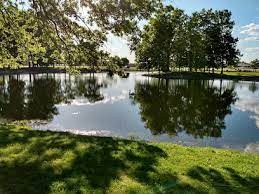Bunker Hill Native Trail and Settlements
Introduction
Text-to-speech Audio
The Bunker Hill Indian Trail historical marker lies at the entrance of Mae Meissner Whitaker Park on Bunker Hill Road/Illinois Route 159. This historical marker provides a brief description of the history of the Indigenous people who inhabited the region of Bunker Hill and the 18-mile trail through the prairie used by migrating Native Americans.
Images


Backstory and Context
Text-to-speech Audio
The present-day community of Bunker Hill, Illinois was originally known as Wolf Ridge, named for the breeding area and denning ground of a large number of wolves. Archeological digs carried out between 1954 and 1973 determined that Native people were well-established in the region over a long period of time. Excavations revealed a Middle Woodland period/Hopewellian culture (about 150 BCE –250/300 CE). In addition, archeological studies identified Native American burial mounds bordering Macoupin Creek and found no less than 44 settlements prior to the arrival of white settlers within the present-day county boundaries. The descendants of these early inhabitants include the Illini, Peoria, Kickapoo, and Winnebago nations. These groups occupied the Bunker Hill region with camping grounds situated near present-day North Washington and West Morgan Streets, and northeast of Bunker Hill near the Millville School.
As American settlers began moving into the region, tensions grew with the Native nations. When the War of 1812 erupted with England, white Americans feared that the neighboring Peoria, Kickapoo, and Winnebago would ally with the British. In September of 1812, the territorial governor, Ninian Edwards (the founder of Edwardsville), led a battalion of 350 cavalrymen from nearby Fort Russell. They traveled along the established trail through present-day Bunker Hill en route to the large Peoria settlement along the Illinois River. Edwards hoped to crush the Native nations before they could join with England and attack the American frontier.
When Illinois became a state in 1818, there were approximately 40 American settlers in the Bunker Hill area. The Americans farmed the rich soil, but they also traded with Peoria, Kickapoo, and Winnebago people in the area. Researchers document the last known encampment of Native people in what is now Bunker Hill to be in 1828. By 1830, the U.S. government forcibly removed the Illini, Peoria, Kickapoo, and Winnebago tribes to the west side of the Mississippi River.
Bunker Hill Indian Trail Historical Marker Inscription:
“During the historical period, the earliest inhabitants of the present-day community of Bunker Hill were the Peoria, Kickapoo, and Winnebago Indians who established an encampment near North Washington and West Morgan Streets. Another Native American site was northeast of Bunker Hill near the Millville School area.
From Fort Russell in Madison County to the old watering place at the head of Paddock’s Creek northeast of town, the eighteen-mile trail ran in a generally straight course through the prairie along the dividing ridge between the waters and timbers of Paddock’s Creek on the east, and Indian Creek on the west.
Native Americans on their northern and southern migrations were accustomed to stopping here near a large spring for water. Soon after the territory opened to American settlement, the indigenous populations were forced across the Mississippi River. The last Native American encampment in Bunker Hill was recorded in 1828, when five wigwams, which stood at the head of Wood River, were taken down and removed to a site further west.”
Written by Reed Richardson, Edited by Jessica Guldner
Sources
Bunker Hill, Il Landmarks - Macoupin County, <http://macoupincountyil.gov › bunker_hill>, accessed 26 February 2022.
“Bunker Hill, IL – Bunker Hill, Illinois Map & Directions.” MapQuest
<https://www.mapquest.com › bunker-hill-il-282034554>, accessed 3 March 2022.
Carney, Lucille. “Students Record History of Bunker Hill.” (Carlinville, Illinois), Aug. 10, 1970.
City of Bunker Hill Homepage, <https://cityofbunkerhillil.org>, accessed February 2022.
Gibson, Arrell Morgan. The Kickapoos: Lords of the Middle Border, Norman Oklahoma: University of Oklahoma Press, 1963.
“Illinois Regional Archives Depository (IRAD) System Illinois State Archives.” Office of the Illinois Secretary of State, <ilsos.gov/departments/archives/IRAD/macoupin.html>, accessed February 2022.
Moore, Luke, David Brady and Tracy Garrison. “Documenting the Edwards Trace”, <https://www.academia.edu/43434610/Documenting_the_Edwards_Trace_2019>, accessed 1 April 2022. (Image of Macoupin plant)
MuseumLink Illinois, The Illinois Economy Food Native Americans:Historic:The Illinois:Economy:Food:Gathering (state.il.us) , accessed 20 March 2022.
“Mythic Mississippi Project: cultural heritage promoting community development”, Mythic Mississippi Project, <https://mythicmississippi.illinois.edu/native-illinois/bunker-hill/>, accessed 17 March 2022.
Moore, Luke, David Brady and Tracy Garrison. “Documenting the Edwards Trace”, <https://www.academia.edu/43434610/Documenting_the_Edwards_Trace_2019>, accessed 1 April 2022. (Fig. 8 shows 146 mile long path “Edwards Trace” from Edwardsville to Peoria)
“War of 1812 Fort Russell.” Alton Museum of History and Art, Inc. Fall 2010, <https://www.altonmuseum.com/newsletterFall2010c.pdf>, accessed 3 April 2022.
Wiest, Oliver. “Archaeologists dig into Fort Russell's history.” The Intelligencer, April 3, 2012, <https://www.theintelligencer.com/local/article/Archaeologists-dig-into-Fort-Russell-shistory-10432165.php>, accessed 3 April 2022.
